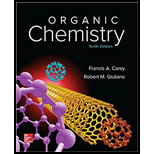
Interpretation:
The structural formulas of the two isomeric bromides formed in the reaction of
Concept introduction:
Secondary alcohols undergo nucleophilic substitution via a modified
An
The nucleophile can then attack the planar carbocation from below the plane as well as from above the plane, leading to a racemic mixture of products.
The product with inverted symmetry is generally favored because the proximity of the water molecule and the carbocation formed in the first step hampers the attack of nucleophile from that face.
For an optically active alcohol with more than one chirality centers, only the absolute configuration at the carbon atom bearing the hydroxyl group changes while the absolute configuration at the other chiral center remains the same.
Want to see the full answer?
Check out a sample textbook solution
Chapter 5 Solutions
ORGANIC CHEMISTRY (LOOSELEAF)-PACKAGE
- What is the name of the following compound? SiMe3arrow_forwardK Draw the starting structure that would lead to the major product shown under the provided conditions. Drawing 1. NaNH2 2. PhCH2Br 4 57°F Sunny Q Searcharrow_forward7 Draw the starting alkyl bromide that would produce this alkyne under these conditions. F Drawing 1. NaNH2, A 2. H3O+ £ 4 Temps to rise Tomorrow Q Search H2arrow_forward

 Organic ChemistryChemistryISBN:9781305580350Author:William H. Brown, Brent L. Iverson, Eric Anslyn, Christopher S. FootePublisher:Cengage Learning
Organic ChemistryChemistryISBN:9781305580350Author:William H. Brown, Brent L. Iverson, Eric Anslyn, Christopher S. FootePublisher:Cengage Learning

